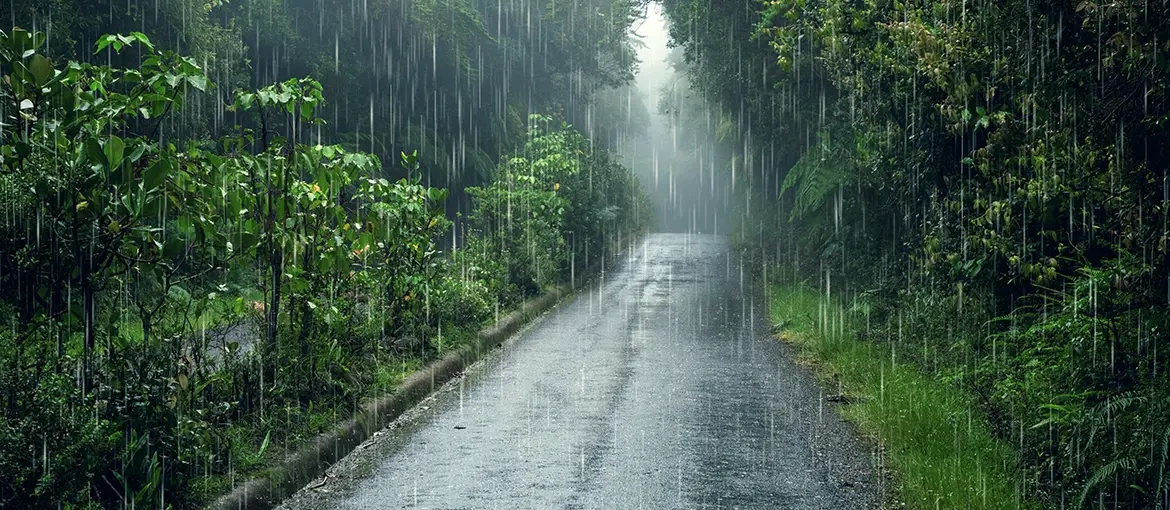
06
AugThe Indian subcontinent resides one of the most interesting weather seasons in the whole wide world - the Indian Monsoon. Because of this weather, there is a significant impact on millions of lives of people in this country; it shapes their daily routines, determines many agricultural practices, and overall well-being.
Generally, this season falls somewhere between June and September - a window that is happily welcomed by our residents to feel a sense of relief after the scorching summer heat.
It is primarily driven by the contrast in temperatures between the landmass of India and the surrounding oceanic waters. As summer approaches, the Indian landmass heats up significantly, creating low-pressure areas. The Indian monsoon is a captivating weather phenomenon that shapes the lives of people, agriculture, and ecosystems in the Indian subcontinent. Its arrival brings relief from the summer heat, replenishes water sources, and supports agricultural productivity.
However, it is also crucial to highlight the massive impact that this season has; it can vary greatly; ranging from floods to droughts. When such an impact occurs, it is necessary to be prepared with effective management strategies.
The study of the Indian monsoon continues to intrigue scientists and enthusiasts alike, as they strive to unravel its complexities and improve our understanding of this extraordinary weather pattern.
Just like these facts, the experts at Aashi have put together this comprehensive guide. It consists of similar intriguing facts about the Indian Monsson, so keep reading!
Indian monsoons are characterised by the seasonal reversal of wind patterns. During summer, hot air over the Indian subcontinent rises, creating a low-pressure area. This draws in moisture-laden winds from the Indian Ocean, resulting in the southwest monsoon. In winter, the wind patterns reverse, and dry air flows from land to the ocean, known as the northeast monsoon.
Indian monsoons are vital for agriculture and the overall economy of the region. The rains brought by the monsoon provide water for crops, replenish reservoirs, and fill rivers, ensuring a steady water supply for irrigation, hydroelectric power generation, and other industries.
The onset of the monsoon is eagerly awaited in India. The India Meteorological Department (IMD) predicts the monsoon onset date, which is typically around June 1 on the southwestern coast of India. The arrival of the monsoon is celebrated with enthusiasm across the country.
The monsoon progresses across India in a northward direction. It usually reaches the southernmost state of Kerala in the first week of June, covering the entire country by mid-July. The onset and progression of the monsoon are closely monitored by the IMD to aid agricultural planning and disaster management.
One thing that is absolutely constant in the Indian monsoon is variability. Many factors like El Niño and La Niña events in the Pacific Ocean, sea surface temperatures, and atmospheric conditions can determine the intensity and overall distribution of rainfall during the season. This variability can impact agriculture, water resources, and the overall economy.
When it comes to heavy rainfall, they can largely affect the normal cycle. Meaning, they can lead to devastating floods, especially in low-lying areas and river basins.
These floods impact tremendously human life, damage infrastructure, and can cause a widespread displacement of people.
To overcome this problem, attempts are being made to give accuracy while weather forecasting and early warning signs to lower the impact of floods.
The withdrawal of the monsoon from India occurs from September to October. It starts retreating from the northwestern region, gradually moving towards the southeast. The retreat is marked by a reduction in rainfall and a decrease in humidity.
Indian monsoons have a profound influence on the culture, festivals, and daily life of the people. Monsoon festivals like Teej, Raksha Bandhan, and Onam are celebrated during the rainy season. The monsoon also inspires various forms of art, literature, and music in different parts of India.
Monsoon tourism is quickly gaining popularity in India. This is especially true in a few regions such as the Western Ghats - they have breathtaking views during rain. Many people visit these areas to experience the lush green landscapes, waterfalls, and misty mountains created by the heavy rains.
While monsoons are crucial for agriculture, they can also pose challenges. Excessive rainfall can lead to waterlogging, crop diseases, and landslides. Droughts, on the other hand, can occur during weak monsoon years, affecting agricultural productivity and water availability.
Indian monsoon has several elements that determine its nature. These elements are spread across our entire country; they come together and determine the nature of this season every year.
Now that you know a few fascinating facts about the monsoon season, it’s time to get prepared for rain.
Aashi has the best quality rainwear - the monsoon accessory that can elevate your style and protect you from heavy rains.
Place your orders with us today!